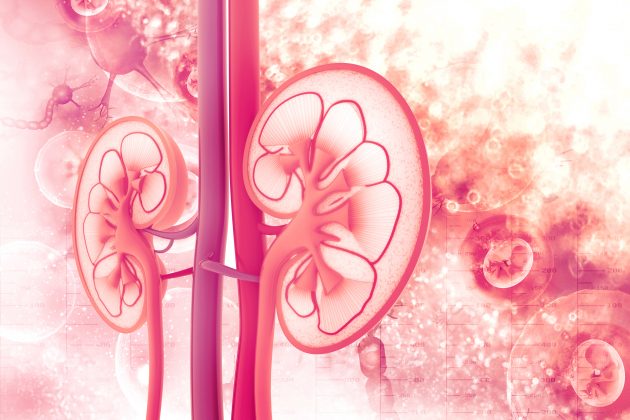Because 50% of hospitalizations related to influenza occur in adults ≥65 years of age, older age is a key risk factor. Chronic kidney disease (CKD) is related to age and affects more than 35% of older adults in the United States, and poses a higher risk factor for cardiovascular events and infections. Older adults with CKD are an important target in population-based vaccine policies.
However, there are few data available in the prevalence and relative effectiveness of influenza vaccine in older adults with reduced kidney function. Junichi Ishigami, MD, MPH, and colleagues conducted an observational cohort study to examine the prevalence and effectiveness of influenza vaccination among adults ≥65 years of age with and without reduced kidney function. The study participants were members of Geisinger Health System, a large community-based healthcare cohort. The researchers sought to test the hypothesis that there would be an association between influenza vaccination and reduced incidence of hospitalization related to influenza (pneumonia/influenza, coronary heart disease, and heart failure). Study results were reported in the American Journal of Kidney Diseases [2020;75(6):887-896].
The data represented 454,634 person-seasons among 110,968 individuals ≥65 years of age in the Geisinger Health System between the 2005 and the 2015 influenza seasons. Using inverse probability weighting, baseline characteristics were matched between those with and those without vaccination. The outcomes of interest were incident hospitalization with pneumonia/influenza, coronary heart disease, and heart failure during influenza season stratified by estimated glomerular filtration rate (eGFR) ≥60 mL/min/1.73 m2, 30 to 59 mL/min, 1.73 m2, and <30 mL/min/1.73 m2.
Characteristics were overall comparable between the 2005-2006 and 2014-2015 influenza seasons. Of the 55,211 individuals in the 2014-2015 influenza season, mean age was 75.5 years, 57.7% were women, and 0.8% were Black. Thirty-one percent had eGFR of 30 to 59 mL/min/1.73 m2 and 2.8% had eGFR <30 mL/min/1.73 m2. The prevalence of comorbid conditions was diabetes 27.0%, coronary heart disease 19.9%, chronic obstructive pulmonary disease (COPD)/asthma 20.4%, cancer 15.5%, and cerebrovascular disease 11.6%.
In the unweighted sample, individuals who received influenza vaccination were more likely to have diabetes, coronary heart disease, COPD/asthma, cancer, cerebrovascular disease, and heart failure, but less likely to have dementia. Those in the vaccination cohort also had more frequent outpatient visits and hospitalizations compared with those who did not receive influenza vaccination. Following inverse probability weighting, the differences became substantially smaller and baseline variables were similar between the cohorts that did and did not receive an influenza vaccination.
In the 2005-2006 influenza season, the prevalence of influenza vaccination was 53.3%; the prevalence remained largely constant between 60% and 66% from 2006 through 2015. There were nominal differences across eGFR categories in the prevalence of vaccination. In the 2014-2015 influenza season, for the eGFR categories ≥60, 30 to 59, and <30 mL/min/1.73 m2, the prevalence of vaccination was 62.9%, 64.5%, and 57.3%, respectively. In the subgroups with and without diabetes, there was ~10% higher prevalence of vaccination among individuals with diabetes. Of those who received an influenza, 99% received a standard dose.
During 442,417 person-seasons among 109,096 individuals, there were 3709 hospitalizations with pneumonia/influenza, 12,842 with coronary heart disease, and 6543 with heart failure. The incidence per person-season among those who did not receive influenza vaccination was 0.9%, 2.9%, and 1.5%, respectively. The incidence was disproportionally higher in lower eGFR categories for each outcome (eg, 2.2% among those not vaccinated with eGFR <30 mL/min/1.73 m2 vs 0.7% with eGFR ≥60 mL/min/1.73 m2 for pneumonia/influenza).
There was an association between influenza vaccination and ~10% lower odds of hospitalization for pneumonia/influenza (odds ratio [OR], 0.86; 95% confidence interval [CI], 0.79-0.93), coronary heart disease (OR, 0.93; 95% CI, 0.88-0.97), and heart failure (OR, 0.92; 95% CI, 0.86-0.99). When assessed by eGFR category, the association was generally consistent in eGFR ≥30 mL/min/1.73 m2, but not significant in eGFR <30 mL/min/1.73 m2.
Results of analysis of the number needed to vaccinate found that overall 354 individuals should be vaccinated to avert one case of influenza-related hospitalization. When numbers needed to vaccinate were estimated by eGFR of 30 to 59 mL/min/1.73 m2 versus ≥60 mL/min/1.73 m2, the numbers needed to vaccinate were lower in eGFR 30 to 59 mL/min/1.73 m2 compared with ≥60 mL/min/1.73 m2.
Limitations to the study cited by the authors included possible residual confounding and selection by identification, relying on International Classification of Diseases-Ninth Edition codes to determine the outcome that could have led to misclassification, the possibility that some individuals may have been vaccinated outside the Geisinger system, and analyzing the effectiveness only among those who stayed at risk until December 1.
The researchers said, “In conclusion, one-third of older adults did not receive an influenza vaccination even when eGFRs were low. Because our study confirmed a reduced incidence of hospitalizations among older adults with GFR ≥30 mL/min/1.73 m2 receiving influenza vaccination, it is important to improve adherence to influenza vaccination in this population. This is particularly critical for older adults with eGFR of 30 to 59 mL/min/1.73 m2 given their low number needed to vaccinate. The lack of evident effectiveness of influenza vaccination in eGFR <30 mL/min/1.73 m2 warrants future studies to determine the optimal influenza prevention strategies in this high-risk population.”
Takeaway Points
- Researchers conducted an observational cohort study to examine the effectiveness of influenza vaccination among older adults with and without reduced kidney function.
- The prevalence of influenza vaccination was 53.3% in 2005-62006 and then remained largely constant between 60% and 66% from 2006 through 20215.
- The incidence of hospitalization was higher in patients with lower estimated glomerular filtration rate (eGFR): 2.2% per person-season among those not vaccinated with eGFR <30 versus 0.7% with ≥60 mL/min/1.73 m2 for pneumonia/influenza.
Credit: Original article published here.










